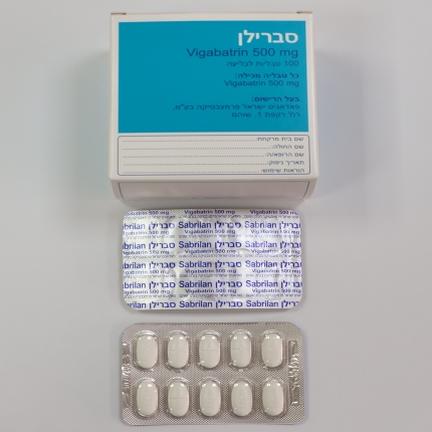Quest for the right Drug

סברילן SABRILAN (VIGABATRIN)
תרופה במרשם
תרופה בסל
נרקוטיקה
ציטוטוקסיקה
צורת מתן:
פומי : PER OS
צורת מינון:
טבליות מצופות פילם : FILM COATED TABLETS
עלון לרופא
מינוניםPosology התוויות
Indications תופעות לוואי
Adverse reactions התוויות נגד
Contraindications אינטראקציות
Interactions מינון יתר
Overdose הריון/הנקה
Pregnancy & Lactation אוכלוסיות מיוחדות
Special populations תכונות פרמקולוגיות
Pharmacological properties מידע רוקחי
Pharmaceutical particulars אזהרת שימוש
Special Warning עלון לרופא
Physicians Leaflet
Adverse reactions : תופעות לוואי
4.8. Undesirable effects Summary of the safety profile Visual field defects ranging from mild to severe have been reported frequently in patients receiving vigabatrin. Severe cases are potentially disabling. The onset is usually after months to years of vigabatrin therapy. Pooled data from prevalence surveys suggest that as many as 1/3 of patients receiving vigabatrin therapy develop visual field defects (see also section 4.4). Approximately 50% of patients in controlled clinical studies have experienced undesirable effects during vigabatrin treatment. In adults, these were mostly central nervous system-related such as sedation, drowsiness, fatigue and impaired concentration. However, in children, excitation or agitation is frequent. The incidence of these undesirable effects is generally higher at the beginning of treatment and decreases with time. As with other antiepileptic drugs, some patients may experience an increase in seizure frequency, including status epilepticus with vigabatrin. Patients with myoclonic seizures may be particularly liable to this effect. New-onset myoclonus and exacerbation of existing myoclonus may occur in rare cases. Tabulated list of adverse reactions Undesirable effects ranked under headings of frequency are listed below, using the following convention: Very common (≥1/10); common (≥1/100 to <1/10); uncommon (≥1/1,000 to <1/100); rare (≥1/10,000 to <1/1,000); very rare (<1/10,000); not known (cannot be estimated from the available data). Very common Common Uncommon Rare Very rare Not known Blood and anaemia lymphatic system disorders Psychiatric agitation, hypomania, suicide attempt hallucination disorders* aggression, mania, nervousness, psychotic depression, disorder paranoid reaction insomnia . Nervous system somnolence speech disorder, coordination encephalopathy** optic neuritis Cases of brain MRI disorders headache, abnormal abnormalities have dizziness, (ataxia) been reported, paraesthesia, intramyelinic disturbance in oedema attention and (particularly in memory infants) (see impairment, sections 4.4 and mental 5.3). impairment (thought disturbance), tremor Eye disorders visual field vision blurred, retinal disorder optic atrophy Reduced visual defect diplopia, (mainly peripheral) acuity nystagmus Gastrointestinal nausea, disorders vomiting, abdominal pain Hepato-biliary hepatitis disorders Skin and alopecia. rash angioedema, subcutaneous urticaria tissue disorders Musculoskeletal arthralgia and connective tissue disorders General Disorders fatigue oedema, and administration irritability site conditions Investigations*** weight increased *Psychiatric reactions have been reported during vigabatrin therapy. These reactions occurred in patients with and without a psychiatric history and were usually reversible when vigabatrin doses were reduced or gradually discontinued (see section 4.4). Depression was a common psychiatric reaction in clinical trials but seldom required discontinuation of vigabatrin. **Rare reports of encephalopathic symptoms such as marked sedation, stupor and confusion in association with nonspecific slow wave activity on electroencephalogram have been described soon after the initiation of vigabatrin treatment. Such reactions have been fully reversible following dose reduction or discontinuation of vigabatrin (see section 4.4). ***Laboratory data indicate that vigabatrin treatment does not lead to renal toxicity. Decreases in ALT and AST, which are considered to be a result of inhibition of these aminotransferases by vigabatrin, have been observed. Paediatric population Psychiatric disorders Very common: excitation, agitation Reporting of suspected adverse reactions Reporting suspected adverse reactions after authorisation of the medicinal product is important. It allows continued monitoring of the benefit/risk balance of the medicinal product. any suspected adverse events should be reported to the Ministry of Health according to the National Regulation by using an online form https://sideeffects.health.gov.il In addition, you can report to Padagis via the following address: Padagis.co.il.

שימוש לפי פנקס קופ''ח כללית 1994
Epilepsy which is not controlled by other antiepileptic drugs (in combination with other antiepileptic drugs). יירשם ע"י מנהל מחלקה או יחידה נוירולוגית לחולים לא מאוזנים ע"י תרופות אנטיאפילפטיות אחרות
תאריך הכללה מקורי בסל
01/01/1995
הגבלות
תרופה מוגבלת לרישום ע'י רופא מומחה או הגבלה אחרת
רישום
058 94 27254 00
מחיר
0 ₪
מידע נוסף
